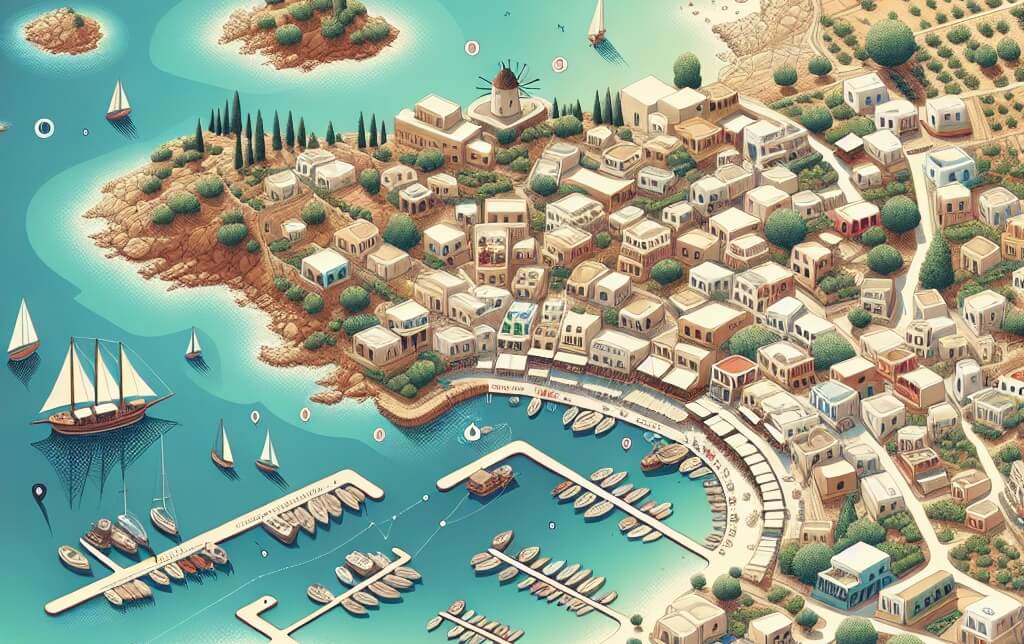
Explore Xanthi Greece Map: Discover Landmarks & Hidden Gems
Exploring the Xanthi Greece map offers a rich tapestry of historical landmarks and hidden gems waiting to be discovered. Situated in the northern region of Greece, Xanthi boasts a unique blend of cultural influences, evident in its architecture, cuisine, and traditions. Landmarks such as the Old Town with its Ottoman-era buildings and the Folklore Museum showcasing the region's heritage provide a glimpse into Xanthi's storied past. Delving deeper into the map reveals hidden gems like the picturesque village of Stavroupoli and the stunning Nestos River Gorge, offering visitors a chance to immerse themselves in the natural beauty of the region. Whether you are a history enthusiast, a nature lover, or simply seeking to uncover the lesser-known treasures of Greece, the Xanthi map promises an enriching and unforgettable experience.
I. Introduction
The city of Xanthi, located in northeastern Greece, is a place of rich cultural heritage and historical significance. Situated near the border with Bulgaria, Xanthi is known for its unique blend of influences from various civilizations that have inhabited the region over the centuries. This city is not only a hub of traditional Greek architecture and art but also a melting pot of diverse cultural traditions, making it a fascinating destination for tourists and historians alike. In this exploration of Xanthi, we will delve into its geographical features, historical landmarks, and cultural attractions to gain a comprehensive understanding of this enchanting city in Greece.
II. Xanthi Greece Map
The Xanthi Greece map provides a detailed overview of the geographical layout of the city of Xanthi, located in northeastern Greece. This map serves as a valuable resource for individuals seeking to navigate the streets, landmarks, and points of interest within the city. By consulting the Xanthi Greece map, visitors can efficiently plan their itinerary, locate important sites such as museums, historical buildings, and restaurants, and gain a better understanding of the overall spatial organization of the city. Additionally, the map may also highlight key transportation routes, public facilities, and other essential information that can enhance the overall travel experience in Xanthi.
III. Border Bulgaria
The border between Greece and Bulgaria in the region of Xanthi plays a significant role in the geopolitical landscape of the area. It serves as a point of connection and separation between the two countries, embodying the complex history and relationship between them. The border is not merely a physical line on a map but represents a junction of cultures, economies, and political influences. It is a focal point for issues of security, trade, and migration, reflecting the broader dynamics at play in the region. The region of Xanthi, with its border with Bulgaria, serves as a microcosm of the larger geopolitical forces shaping Southeastern Europe.
IV. Macedonia Thrace
IV. Macedonia Thrace is a region located in the northeastern part of Greece, bordering Bulgaria to the north and Turkey to the east. Within this region lies the city of Xanthi, known for its cultural diversity and historical significance. Xanthi is a vibrant city with a rich blend of Greek, Turkish, and Slavic influences, evident in its architecture, cuisine, and traditions. The city's location near the Nestos River and the Rhodope Mountains makes it a picturesque destination for nature enthusiasts and history buffs alike. With its unique blend of cultures and stunning natural beauty, Xanthi in Macedonia Thrace offers visitors a truly immersive and enriching experience.
V. Xanthi Xanthi
V. Xanthi is a region located in northeastern Greece, known for its rich history, diverse culture, and picturesque landscapes. Xanthi is a city within this region, characterized by its unique blend of Ottoman, Byzantine, and Greek influences. The city is renowned for its well-preserved old town, where narrow cobblestone streets wind past colorful neoclassical buildings and traditional tavernas. Xanthi is also home to a vibrant university community, adding a youthful energy to its historic surroundings. The region of Xanthi offers visitors a chance to explore archaeological sites, enjoy outdoor activities in the surrounding mountains, and experience the warm hospitality of its residents.
VI. Travel Itinerary
For the travel itinerary in Xanthi, Greece, it is essential to consider the key points of interest and attractions in the region. Begin the itinerary by exploring the historical Old Town of Xanthi, known for its well-preserved Ottoman architecture and charming cobblestone streets. Next, visit the Folklore Museum to learn about the cultural heritage of the region. Take a leisurely stroll along the picturesque Xanthi riverside, where you can admire the beautiful scenery and relax in one of the local cafes. Don't miss the opportunity to explore the nearby Nestos River Delta National Park, where you can enjoy nature walks and birdwatching. Wrap up the itinerary by indulging in the local cuisine at one of Xanthi's traditional tavernas, savoring dishes like souvlaki, moussaka, and baklava.
VII. Tourist Map
The tourist map of Xanthi, Greece, plays a crucial role in guiding visitors through the city's attractions, historical sites, and cultural landmarks. By providing detailed information on key points of interest such as museums, churches, and traditional neighborhoods, the map serves as a valuable tool for tourists seeking to explore the rich heritage and beauty of Xanthi. Additionally, the inclusion of transportation routes, accommodations, and dining options on the map facilitates a seamless and enjoyable travel experience for visitors. Overall, the tourist map of Xanthi serves as an indispensable resource for travelers looking to make the most of their stay in this charming Greek city.
VIII. Western Thrace
Western Thrace, also known as the Xanthi region in Greece, is a geographically and culturally significant area located in the northeastern part of the country. This region is characterized by its diverse population, with a significant presence of Turkish and Pomak communities alongside the Greek population. The city of Xanthi serves as a hub of cultural exchange and interaction, with its picturesque old town and vibrant marketplaces attracting visitors from far and wide. The Western Thrace region is also known for its rich history, with influences from various civilizations reflected in its architecture, cuisine, and traditions. Overall, Western Thrace stands as a testament to the harmonious coexistence of different cultures and serves as a unique melting pot of diversity within Greece.
IX. East Macedonia
East Macedonia, specifically Xanthi, is a region located in northeastern Greece, bordering Bulgaria to the north. Known for its rich cultural heritage and diverse population, Xanthi offers a blend of traditions from various ethnic groups, including Greek, Turkish, and Pomak communities. The region is characterized by its picturesque landscapes, with lush forests, rolling hills, and the flowing Nestos River. Xanthi is also home to a number of historical sites, such as the old town with its traditional Ottoman architecture and the ancient city of Abdera. Overall, East Macedonia, and particularly Xanthi, is a fascinating destination for those seeking to explore the unique cultural tapestry of this region in Greece.
X. Old City
X. Old City in Xanthi, Greece, is a historically significant area that showcases the rich cultural heritage of the region. Situated in the northern part of Greece, Xanthi's Old City is known for its well-preserved Ottoman architecture, narrow cobblestone streets, and traditional houses with wooden balconies. Visitors can explore the charming alleys lined with local shops selling handicrafts, traditional textiles, and local delicacies. The area also features several historic landmarks such as the clock tower, mosques, and churches, providing a glimpse into the city's diverse past. Overall, X. Old City is a must-visit destination for those interested in history, architecture, and cultural experiences in Greece.
XI. Moslem Minority
The Moslem minority in Xanthi, Greece, known for their unique cultural and religious practices, constitutes a significant segment of the city's population. Comprised mainly of Turkish and Pomak communities, this minority group has played a crucial role in shaping the social fabric of Xanthi. Their presence is evident in the architecture, cuisine, and traditions of the city, adding to its diverse and multicultural identity. Despite facing challenges and discrimination at times, the Moslem minority in Xanthi continues to preserve their heritage and contribute to the rich tapestry of the city's cultural landscape. Efforts to promote intercultural dialogue and mutual understanding between the Moslem minority and the broader community are essential for fostering harmony and inclusivity in Xanthi.
XII. Treaty of Lausanne
The Treaty of Lausanne, signed on July 24, 1923, marked the official end of hostilities between Turkey and the Allied Powers following World War I. This treaty redefined the borders of Turkey and established the modern boundaries of the country. In the context of the Xanthi, Greece map, the Treaty of Lausanne is significant as it solidified the territorial integrity of both Turkey and Greece, including the region of Xanthi. The treaty aimed to promote peace and stability in the region by resolving territorial disputes and establishing diplomatic relations between the signatory countries. Overall, the Treaty of Lausanne played a crucial role in shaping the geopolitical landscape of the Eastern Mediterranean and continues to influence international relations in the region to this day.
XIII. House Shadow
XIII. House Shadow, as depicted on the Xanthi, Greece map, likely refers to a specific residential property or building within the region of Xanthi. The term "House Shadow" may denote a house that is cast in shadow due to its positioning in relation to the sun or surrounding structures. It is possible that this designation serves as a navigational or descriptive marker on the map, helping individuals locate or identify this particular house within the area of Xanthi. Further details or context regarding House Shadow would be necessary to provide a more comprehensive understanding of its significance within the map of Xanthi, Greece.
XIV. Time Region
In the context of the task related to the 'xanthi greece map', XIV. Time Region refers to the specific time zone or temporal division associated with the region of Xanthi in Greece. Understanding the time region is crucial for accurate navigation and coordination of activities within the area, as it dictates the local time standard observed by residents and businesses. By identifying and adhering to the designated time region, individuals can effectively plan their schedules, meetings, and travel arrangements in Xanthi, ensuring smooth and efficient operations. It is essential to consult reliable sources or official references to ascertain the precise time region applicable to Xanthi, thus avoiding any potential confusion or discrepancies in timekeeping.
XV. Minority Greece
Xanthi, located in northeastern Greece, is known for its diverse population that includes a significant minority group. The XV. Minority Greece refers to the Pomak community in the region, who are of Slavic origin and predominantly Muslim. The presence of this minority group adds to the cultural richness and diversity of Xanthi, contributing to the unique tapestry of the region. The Pomak community has its own distinct traditions, language, and customs, which have been preserved and celebrated over generations. Understanding and respecting the presence of minority groups like the Pomaks in Xanthi is essential for promoting inclusivity and fostering a harmonious coexistence among the various communities that call the region home.
XVI. Conclusion
In conclusion, the city of Xanthi, Greece, boasts a rich cultural heritage and a vibrant community that is reflected in its diverse landmarks and attractions. The map of Xanthi provides a comprehensive overview of the city's layout, highlighting key points of interest such as the Old Town, the Folklore Museum, and the Xanthi Carnival. Navigating through the streets of Xanthi via the map enables visitors to immerse themselves in the city's history and traditions, making it an invaluable tool for exploration and discovery. Ultimately, the Xanthi map serves as a gateway to unlocking the beauty and charm of this picturesque Greek city, inviting travelers to experience its unique blend of past and present.









